
by California Casualty | Educators |
Fire safety comes in many forms- drills, procedures, seminars, dedicated months/weeks, etc. But nothing prepares you for the scare of an unplanned fire alarm, especially when you are in the classroom. No matter what, when you are a teacher, your students are your first priority. It’s the extra effort that you put in as a teacher that ensures everyone stays safe during an emergency, like a fire.
In honor of Fire Safety Month, we wanted to share why and when fires happen in schools, and what else you can do to encourage fire safety.
A Brief History of School Fire Safety
On March 4, 1908, a fire broke out at the Lake View School in Ohio. There was only one staircase in the four-story building with no fire doors or exits. Between the oiled floors and the wood interior, the fire quickly caught and trapped students and staff inside, ultimately killing 172 students, 2 teachers, and a rescuer.
That tragedy did more than just make headlines. It changed the face of fire safety in schools and public buildings. As a result, today’s schools have fire escapes and exit plans, sprinkler systems and alarms, and even push bars on exit doors – rather than doorknobs — for easy access to the outside.
School Fire Trends
Schools may not have oiled floors anymore but they do have plenty of flammable materials; furniture, paper, cooking materials, electric cords, and even chemicals in the science lab.
Whether as a result of these hazards or something else, there were an average of 3,230 school fires annually from 2014-2018, according to the National Fire Protection Association.
-
- Fires most often started in a bathroom or school locker.
- Two-thirds of the fires occurred between the hours of 8 a.m. and 4 p.m., roughly when students are present at school.
- Two out of every five fires were started intentionally.
Prevention and preparedness are key to staff and students staying safe in the event of a fire.
Fire Safety Checklist for Your Classroom
You can set the stage for fire safety with your students in your classroom. Here’s how.
-
- Practice fire drills with students so that they know how to respond to a fire alarm.
- Pair special needs students with a classmate for drills.
- Make sure your room map clearly marks exits and shows two or more escape routes.
- Keep your class list with contact information by the door so you can easily grab it as you leave.
- Make sure combustible materials are away from heaters.
- Check that the decorations hanging from the ceiling do not block sprinklers.
- Make sure there are no flammable items or paper on or above the exit door.
- Check electrical cords and appliances for wear. Disconnect them when not in use.
- Avoid overloading outlets.
- Do not use candles or open flames in the classroom.
- Invite your local fire department to come in for a presentation on fire safety.
- Incorporate a fire safety curriculum. You’ll find great resources on websites like Fire Safe Kids and Fire Facts.
Fire Safety Checklist for Your School
Fire safety is a schoolwide effort. You may wish to share this checklist with your school administrator.
-
- Store trash away from the building; lock lids for extra safety.
- Boost exterior lighting with motion sensors.
- Trim trees and shrubs around the building. Consider fire-resistant landscaping, which are shrubs and trees that store water and take longer to burn. Plant them around the perimeter 30 feet from the school and 10 feet from each other.
- Put alarms on doors, windows, ventilator openings, roof hatches to prevent vandalism that can lead to arson.
- Ask neighbors to be alert for signs of vandalism.
- Make sure there is clear access to exits and to alarms.
- Hold monthly fire drills with staff and students that are both scheduled and unexpected.
- Review the emergency evacuation plan annually and make sure the school is up to code from sprinkler systems to cafeteria equipment, unobstructed doorways, and more. Your local fire department can help guide you.
- Do a walk-through with staff so they know the locations of the fire exits.
- Do not allow cars to block fire lanes in the event of an emergency.
Fire Safety Checklist for the College Dorm
College is when students are on their own for the first time. Share this list with your college-age son or daughter to keep fire safety top of mind.
-
- Cook only in designated areas in the dorm building.
- Keep cooking areas clutter-free.
- In case of a fire in a microwave, shut the door and unplug the appliance. Wait until the first goes out.
- Make sure you have a working smoke alarm.
- Identify the two closest exits to your room.
- Report fire equipment that is vandalized.
- Know the locations of the fire alarms and how to use them.
You may not be able to predict when a fire will break out, but you can anticipate it and practice fire safety- at home and in the classroom.
Stay prepared, stay safe.
This article is furnished by California Casualty, providing auto and home insurance to educators, law enforcement officers, firefighters, and nurses. Get a quote at 1.866.704.8614 or www.calcas.com.
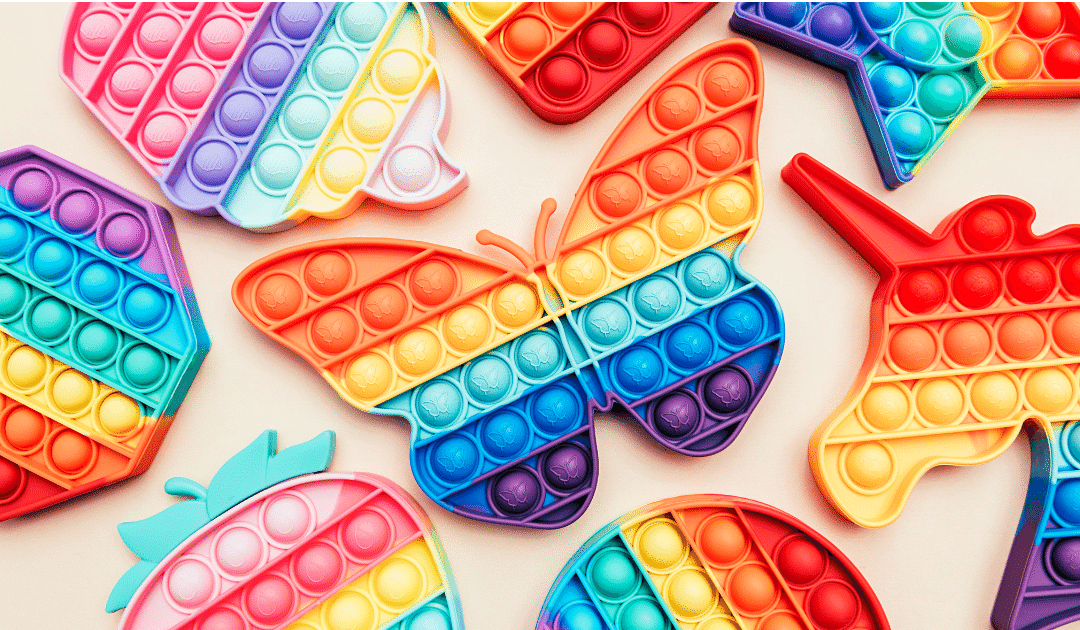
by California Casualty | Educators |
You’ve heard the craze, but have you jumped on the fidget tool or desk pet teaching trend?
Fidget toys and desk pets might just sound like the latest fad in education, but they are both actually easy-to-use tools that educators can implement to support attentiveness and positive classroom behavior.
And it’s time to get on board.

Learning to Focus with Fidget Tools
Fidgeting is our body’s way of naturally releasing energy (and we know children have a ton of energy). Most teachers see fidgeting in students when they are continuously getting up to use the restroom or sharpening their pencils, rustling around in their seats, always talking to classmates, doodling during lessons, etc. Many teachers and parents are hesitant that these toys or tools will take their student’s focus off of the task at hand and become a distraction, but that’s often not the case.
Fidget toys or sensory tools are self-regulation objects to help with focus, attention, calming, and active listening. Using intentional fidgeting in the classroom has shown enhanced academic achievement in children with ADHD, anxiety, and other sensory processing differences. That is because the movement of fidget tools, “…causes instant grounding effects by taking the user out of their head and refocuses them back to the present moment” says Licensed Family Therapist Elizabeth Hankin, M.A., LMFT.
How You Can Implement Fidget Tools
It’s important to introduce fidget tools in a structured way so they don’t end up becoming a toy or unnecessary distraction. Follow these steps to easily implement fidget and sensory tools in your classroom.
-
- Start by introducing your students to the sensory systems
- Explain or experiment how each work and can improve focus & calm their mind
- Have them choose their own unique sensory preferences
- Purchase or make sensory tools that will work for your students
And the last and most important step…
-
- Set rules and expectations for the fidget tools
This step is vital to drawing the line between a sensory object and a toy. Set a list of ground rules for your class when it comes time to get the sensory objects out. Make sure to emphasize that they are not to be used as a toy.
You could even have time limits as to when they can be used. For example, some teachers choose to keep sensory objects out throughout the day, while others choose to let their students pick when they would like to have the sensory object with them. To do this you’ll need to help students learn to understand when they might need the device- like to sit through a group reading or to focus during a test. After you introduce the sensory objects and state their purpose, practice completing tasks with (and without) the fidget tools and see what works best for your students.
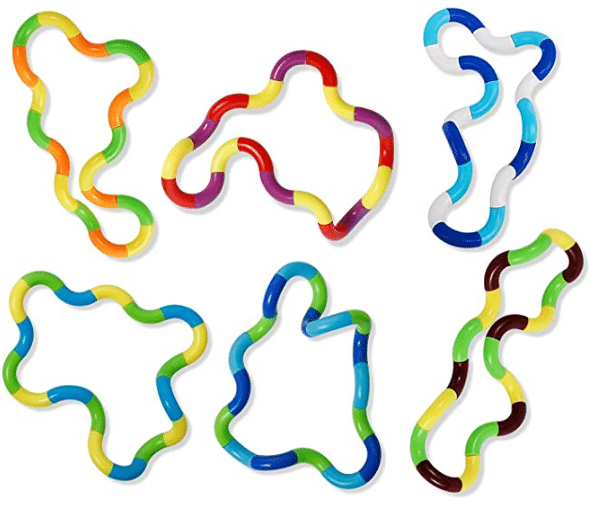
Quick List of Fidget Tools
Remember the goal of fidget tools is to help focus attention and improve learning ability. When you purchase a device it should be a good sensory object; something that has some weight, movement, or texture. Here is an easy list of classroom-friendly sensory objects.
Stress Balls
Pop Bubbles
Bouncy Bands
Fidget Spinners
Infinity Cube
Tangle Toys
Kneadable Erasers
Illusion Balls
Expandable Breathing Ball
Monkey Noodle
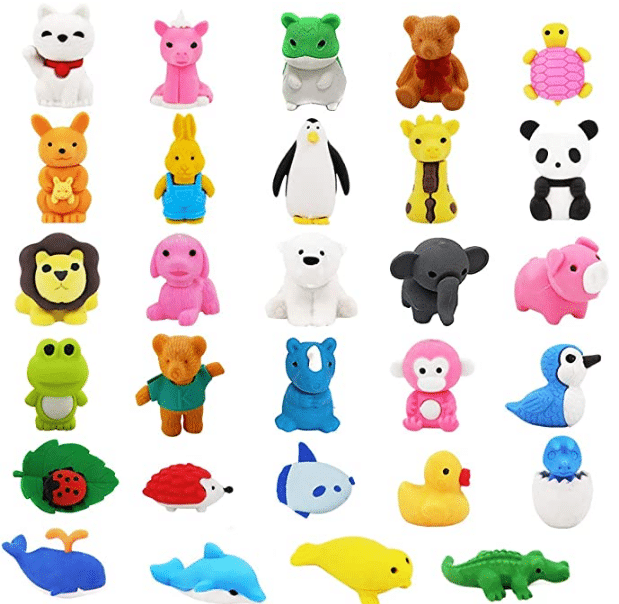
Encouraging Positive Behavior with Desk Pets
Now let’s talk about the other teaching trend that has taken the internet by storm- desk pets. You’ve probably seen the idea all over Teacher TikTok and Instagram, but these little erasers are more than just a cute desk accessory for your students, they are great for positive reinforcement in the classroom!
So what exactly are desk pets? Desk pets are miniature erasers in the shape of animals that students ‘adopt’, keep on their desk (or station), and get to ‘take care of’ throughout the year by building the pets ‘habitat’. The erasers come in different varieties- sea animals, pets, zoo animals, etc. and can be found at stores like Target, Dollar Tree, and Amazon.
Educators across the nation are using these pets as rewards for positive behavior. When students are acting accordingly or do a good deed they will be awarded ‘money’ or a ‘token’ to help purchase their own desk pet. The positive reinforcement doesn’t stop there. They can continue to earn ‘tokens’ to build a habitat and take care of their pet with food, friends, housing, accessories, etc.
How You Can Introduce Desk Toys
Every educator does desk pets differently, so don’t be afraid to make them your own and adapt them to your class. But like, fidget toys it’s important to bring desk pets on as an incentive for your class in a strategic way to make sure they do not become a toy or distraction. Here’s what you can do to introduce them into your classroom.
- Set up a reward process where students can earn ‘money’ or ‘tokens’ for positive behavior, following rules, kind words, etc.
- Create an ‘adoption center’ full of desk pets that are ready to be purchased. You can even make a ‘pet store’ that houses accessories (also in the form of erasers) for their desk pets that they can purchase.
- Set aside time at the end of the day or week where students can cash in and adopt pets or purchase accessories.
- Find a place where your students will house their pets. Will they keep them on their desks? On a side table? In a shoebox ‘community’ that you build in the corner of your room. You decide.
And lastly, just like with fidget tools…
- Set rules and expectations
The time to establish guidelines is before your students even receive their desk pet. How you want to set rules is up to you, but many educators find that putting desk pet rules in their ‘adoption contract’ that they will sign and give back to ‘adopt’ their pet is helpful. And in the event that the student is using the desk pet as a toy it can be taken away- per the signed agreement.
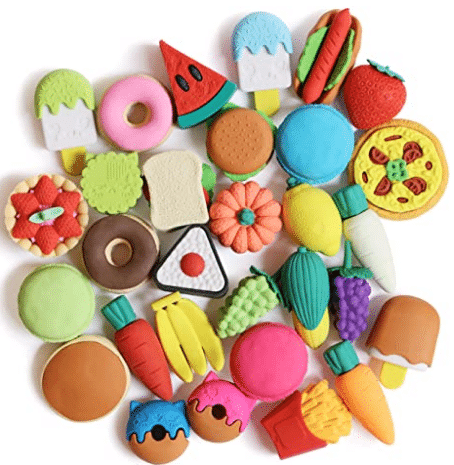
Desk Pets for Your Classroom
Incorporating desk pets may feel a bit overwhelming, but don’t worry once you get started and into a routine, it’s easy and just as rewarding. The most important thing to remember is you can make your classes’ desk adventure whatever you would like it to be- big or small. Don’t feel pressured to do everything every other educator is doing on social media with their desk pets, find what works best with your class, and roll with it!
Now it’s time to start building your own desk pet collection. Click here for some easy and cheap desk pets and accessories to get your class store started.
This article is furnished by California Casualty, providing auto and home insurance to educators, law enforcement officers, firefighters, and nurses. California Casualty does not own any images in this post, they have all been linked to their owners. Get a quote at 1.866.704.8614 or www.calcas.com.

by California Casualty | Educators |
Our Education Blogger is a public school teacher with over a decade of experience. She’s an active NEA member and enjoys writing about her experiences in the classroom.
Struggling to find quality, leveled reading passages for your students? Look no further! We’re sharing our favorite websites that offer free, high-quality, leveled reading passages. language arts
reading skills
Top 6 Websites Offering Free Leveled Reading Passages
CommonLit.org
CommonLit delivers high-quality, free instructional materials to support literacy development for students in grades 5-12. Our resources are flexible, research-based, aligned to the Common Core State Standards, created by teachers for teachers. We believe in the transformative power of a great text, and a great question.
ReadWorks.org
The nonprofit ReadWorks provides K-12 teachers with what to teach and how to teach it—online, for free, to be shared broadly. We provide the largest, highest-quality library of curated nonfiction and literary articles in the country, along with reading comprehension and vocabulary lessons, formative assessments, and teacher guidance. Most importantly, everything ReadWorks does is based on proven cognitive science research, not unproven academic theory.
ReadingVine.com
Free grade leveled reading passages for use in the classroom or at home. Filter by genre, grade, topic, skill, and more.
K5Learning.com
Free reading comprehension worksheets for grades 1-5. Use these free, printable worksheets to practice and improve reading comprehension, vocabulary and writing. Each reading passage is followed by exercises which for younger students focus on recalling information directly from the text and for older students focus on prediction, inference and character traits.
LearnZillion.com
Browse 5-day close reading modules, as well as text-based reading and writing skill videos, for free!
TweenTribune.com
A free teacher tool from Smithsonian Teacher, offering daily AP news articles, Lexile® leveled for K-12, self-scoring quizzes customized by Lexile® level, critical thinking questions, student commenting, Espanol AP articles, weekly lesson plans, weekly video, and weekend “Monday Morning Ready” newsletter as prep for the week ahead.
Have a reading passage, but aren’t sure what its Lexile level is? Try Lexile Analyzer to evaluate any passage. Registered educators (it’s free for you!) have a 1,000-word limit.
We’d love to hear from you! In the comment section below, let us know your favorite sites to find leveled reading passages
This article is furnished by California Casualty, providing auto and home insurance to educators, law enforcement officers, firefighters, and nurses. Get a quote at 1.866.704.8614 or www.calcas.com.

by California Casualty | Educators |
Maybe you’ve enthusiastically jumped into the school year—or maybe the year already feels overwhelming. Take a breath; you’ve got this!
Here’s what you need to know so you can stay focused, practice self-care, and avoid teacher burnout. (For part 1 of this series on self-care, click here.) Burnout is more than just having a bad day. It’s ongoing anxiety and stress that leads to physical and mental exhaustion. You may feel overwhelmed because you’re teaching during a pandemic, trying to enforce a mask mandate while keeping students engaged and on task. Or you may have too much on your plate, and there’s a serious imbalance between work life and home life.
Burnout doesn’t just affect you. It affects everyone you are around- your students, your friends, your family…etc. Fortunately, you can do something about it.
- Create an environment that inspires you.
Your classroom sets the stage for learning. Make it one that inspires you as well as your students. Redecorate your classroom to create the place you want to be. Move the desks; adjust the lighting. Set up a classroom library. If the school allows it, add a favorite scent. When the weather permits, take your class outside for a change of scenery. Importantly, have fun with your students. Try jokes and brain teasers in addition to interesting lessons.
- Separate work and home.
Bringing papers home to grade seems to be every teacher’s “go-to” strategy. After all, you’re tired from a long day; you don’t want to stay at school a minute longer. Instead, try this: don’t take work home. Do your lesson planning and grading at school. Then, when you’re home, forget about work. It’s already done. It may not be possible every single day, but when you can, leave work at work. That will help to create real work-life balance.
- Reduce your workload.
As a teacher, you’re constantly asked to do all sorts of things. Keep your responsibilities manageable. Don’t feel obligated to attend all kinds of school events. Pause before accepting new assignments. Saying “no” is an acceptable response and you shouldn’t feel guilty for it; practice how to do it graciously. Plan ahead as much as possible, so that you can spread out your responsibilities and you’re not caught in a work crunch.
- Incorporate healthy habits.
When you’re at your healthiest, your energy level is high and you can take on the world. Don’t sacrifice healthy habits during a busy school year. That means don’t skip meals and don’t opt for fast or processed food. Fuel your body with a healthy diet of fresh, seasonal foods. Drink plenty of water (timed around your bathroom breaks). Don’t stay up late to get more things done; get enough sleep so you’ll be rested and refreshed. Need a midday boost? Take a micro nap when you get home. Make exercise a regular part of your schedule. Choose activities that you enjoy, such as walking with a friend, biking or taking a fitness class. Importantly, be intentional about self-care. Schedule time each day for yourself.
- Stay mentally stimulated.
Not only are you a teacher, you are a lifelong learner. Keep your brain stimulated by learning about the topics that interest you. Watch a TED talk, read an interesting book, learn something new, and then share it with your students. By example, you’ll make them lifelong learners, too.
- Practice gratitude and spread positivity.
We choose our attitudes. Make yours a positive one. There are many ways to be kind and foster positivity. Call a parent and tell him/her how well his/her child is doing. Share a motivating experience with a colleague. Be the voice of positivity at staff meetings. Show your gratitude to an administrator or fellow teacher. Continue to be grateful for all the positive things in your life.
- Assess your own mental health.
Many educators are suffering from secondary traumatic stress (STS), a term used to describe the stress caused by helping others exposed to trauma. Also known as compassion fatigue, STS is common among teachers during the pandemic. You’re helping students work through the emotions of loss, from the loss of loved ones to missing out on graduations and other milestones. It can take its toll. A doctor or therapist can guide you through these challenges if you are experiencing STS.
- Ask for help when you need it.
You don’t have to do this alone. There are supportive colleagues, friends, and family members available to help. You only need to ask. If things start to become overwhelming, reach out to trusted colleagues for support. Access resources through your school’s Employee Assistance Program, which offers confidential counseling for health/wellness, financial and legal services. If you need a break, consider a sabbatical. Your district may offer paid or unpaid leave while still holding your position.
- Remember why you became a teacher.
You’re making a difference in the lives of young people. Embrace the variety and the ups and the downs as a part of the learning experience for yourself and your students—and celebrate the success.
This article is furnished by California Casualty, providing auto and home insurance to educators, law enforcement officers, firefighters, and nurses. Get a quote at 1.866.704.8614 or www.calcas.com.

by California Casualty | Educators |
Class is back in session! Or at least it’s about it be for the majority of schools across the nation.
Here’s how teachers are feeling about that…
When your summer break ends:
And when you can get back in your classroom:
And then all of the meetings…
When it’s finally time for that first week back:
It sure is good to be back!
In the chaos of it all, remember- you’ve got this!
This article is furnished by California Casualty, providing auto and home insurance to educators, law enforcement officers, firefighters, and nurses. California Casualty does not own any of the photos in this post, all are sources by to their original owners. Get a quote at 1.866.704.8614 or www.calcas.com.
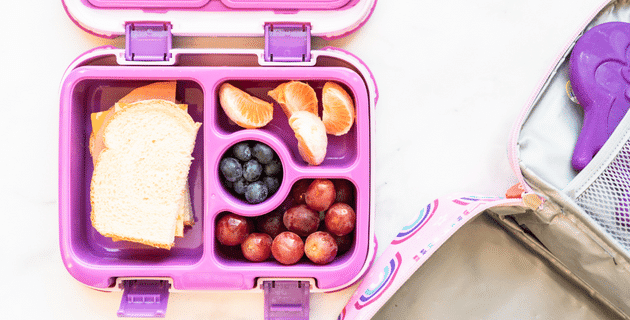
by California Casualty | Educators |
It’s time to get organized for school lunches. Packing lunches for your kids doesn’t have to be a chore, and it doesn’t have to be time-consuming either. Try these creative back-to-school lunch packing hacks to free up an already busy school morning!
#1. Give the sandwich a makeover.
Sandwiches are a school lunch mainstay, but they can be a bit boring even when you pack your child’s favorite, such as PBJ on white bread. Try repackaging the sandwich in these fun ways:
-
- Reinvent your child’s sandwich as a wrap. Use PBJ, meat and cheese, banana and peanut butter, or any filling that your child likes. Roll it up and then slice it. Now it looks like a colorful pinwheel.
- Cookie cutters can transform a traditional sandwich into stars and circles or other fun shapes. Or use them to cut out sandwich ingredients such as cheese or meat. Include crackers so your child and build his or her own sandwich.
- Use a roll, bun, or pita pocket instead of traditional sliced bread.
- Make your own Uncrustables® with a sandwich sealer. You can even freeze them individually in plastic bags and drop them into the lunch box in the morning.
#2. Build a Bento box.
A Bento box is a boxed meal that originated in Japan. It features single-serving compartments for each part of the meal.
-
- Buy a Bento box or make your own by filling a container with colorful silicone muffin liners to separate different foods.
- Create a complete lunch with components in each compartment. Include a main protein, a carb, vegetables, and fruits, and as many bright colors as possible. Choose healthy options that your child likes.
- The key is to keep every section separate so that wet food doesn’t mix with dry.
- Kids generally have only about 30 minutes to eat, and probably less by the time they sit down and get settled, so remember not to overpack.
Pro Tip: Store your (clean) bento box in the freezer, which will help to keep everything cool when you grab it for its next use.
#3. Make a kabob.
Kabobs aren’t just for grilling. (Plus, everything is more fun on a stick.) Just make sure that if you’re giving your child a kabob, the stick and the food portions do not present a danger.
-
- You can stack meats, cheeses, veggies, and/or fruits on kabobs. You can even create themed kabobs such as pizza, with mozzarella, tomato, and pieces of bread.
- Make sure the pieces are small enough that they do not present a choking hazard.
- Cocktail straws make great (and colorful) kabob sticks for children. You can always pre-pierce the food with a real kabob to create the opening, and then stack it on a cocktail straw.
#4. Replace the ice pack.
Ice packs can take up unnecessary room in lunch boxes. Luckily, there are ways for the lunch box contents to do double duty to cool things down.
-
- Freeze your child’s juice box. It will thaw in time for lunch and keep everything cold.
- Use a small plastic bag of frozen berries to keep yogurt cool. Your child can add the berries to the yogurt during lunch.
- Fill a reusable water bottle ¼ full and freeze it on its side. When you’re ready to put it in your child’s lunch box, fill the bottle with water. It will help keep everything cool including the water.
- Yogurt tubes and applesauce packets freeze well and can be used as ice packs.
#5. Use leftovers.
Plan your dinners so that you can repurpose them for lunch. You can get into the habit of preparing lunch when you’re waiting for dinner to cook.
-
- Keep food warm with a food thermos. This will work well for macaroni and cheese, chicken nuggets, Ramen noodles, and other kid favorites.
- Cut up leftover chicken for a chicken wrap.
- Chop extra veggies for lunch when making dinner and store them in bags.
Pro tip: fill your thermos with boiling water in the morning. Let it sit for 5 minutes. Empty it and then fill it up with hot food. It will keep it hotter longer.
#6. Make a school lunch station.
An organized space in your kitchen can help you more easily prepare school lunches. Keep it well-stocked and involve your kids in the preparation.
-
- Find a place in your kitchen, pantry, and refrigerator where you can set up bins for school lunches. If you don’t have an obvious place, create one. Consider a rolling cart or an over-the-door shoe organizer.
- Store lunch options for the week in these spaces, for example, yogurts, fruit, cheese, and cut-up veggies in the fridge, and healthy homemade trail mix, chips, and granola in bins on a shelf.
- Ask kids to assemble a week of snack bags to go. Give them 5 empty bags and an assortment of snacks. Place filled bags on a shelf or a basket on the kitchen counter where they can be easily grabbed.
- Include hooks in your pantry or mudroom to keep lunch bags organized.
And of course, we all know that packing lunches at night is WAY easier than getting up and trying to do it in the morning. Just store them in the fridge and give them to your child before they head out the door.
Happy back to school!
This article is furnished by California Casualty, providing auto and home insurance to educators, law enforcement officers, firefighters, and nurses. Get a quote at 1.866.704.8614 or www.calcas.com.




































